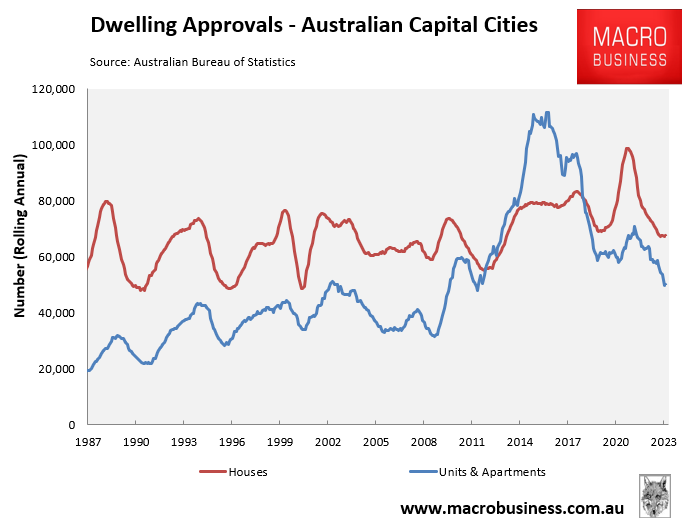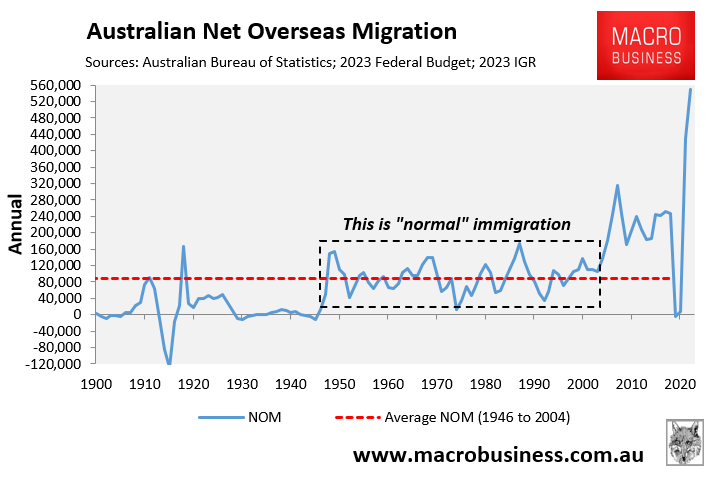YIMBYs, developers, think tanks, and the media urge politicians to relax planning rules so that hundreds of thousands of high-rise apartments can be built quickly across our cities ”missing middle” to accommodate the federal government’s mass immigration policy.
Their arguments ignore overwhelming empirical evidence that the last decade’s high-rise apartment boom was a failure.

The surge in apartment construction occurred alongside increased construction problems and quality concerns, including cracked foundations, water seepage, faulty balconies, and combustible cladding.
Prominent instances include the Opal and Mascot Towers in Sydney, which were evacuated due to substantial structural cracking.
These construction faults have resulted in significant losses for owners and taxpayers, amounting to millions of dollars in repair expenses.
Building regulation consultant Bronwyn Weir cautioned that an “enormous” problem had developed whereby “thousands and thousands of apartments have serious defects in their buildings”.
“Some of these buildings could potentially be a write-off”.
“We have what is now you know, a systemic failure that is quite difficult to unravel”, she said.
According to a survey by the Strata Community Association NSW in October 2021, almost 40% of new apartment complexes in NSW had significant defects.
A parliamentary inquiry in New South Wales revealed substantial structural deficiencies in recently built apartment towers.
Similar structural problems have been discovered across Melbourne, including leaking buildings, mould, and faulty balconies.
On Tuesday, the Herald-Sun reported that a “rotting balcony crisis looms as the ‘next big problem’ for Victorian homes”.
The article noted that thousands of balconies on Victorian homes built over the past 15 years are rotting and at risk of collapse. Building industry insiders claim that severe water defects now pose as big a risk as combustible cladding.
“Any suburb in Melbourne you walk around you can go there’s one, there’s another one – they are everywhere”, Sam Hogg from Property and Strata Group Projects told the Herald-Sun.
“It’s the next big problem and is probably going to be as bad as, if not worse than, combustible cladding.
“One of the big problems is that nobody is doing adequate inspections of waterproofing.
“Some of the builders want to scrimp and save on money so waterproofing membranes are not installed properly, or the membranes are damaged…
“They think they are buying an apartment which is low maintenance, but that is not correct”, Hogg said.
Disturbingly, a paper released by Cladding Safety Victoria (CSV) in late 2023 revealed that over half of the buildings examined had faulty balconies.
Out of a total of 1100 buildings, 52% exhibited dangerous structural problems resulting from water infiltration.
Moreover, 19% of the sample either did not have waterproofing or had inadequate waterproofing.
As a result, engineer Leith Dawes cautioned that buying an off-the-plan apartment in Australia had devolved into a game of “Russian roulette,” given the myriad of often unreported construction defects.
Let’s be honest. These poor-quality high-rise shoeboxes would not have been built had the federal government not chosen to grow the nation’s population like an out-of-control lab experiment through mass immigration.

So long as the federal government continues to run an extreme immigration policy, builders will inevitably cut more corners in the race to build apartments quickly.
In turn, build quality will degrade, construction standards will fall, and the nation will be inundated with thousands more defective high-rise towers.
Instead of pursuing a high-rise slum future, the federal government should restrict immigration to a level commensurate with the country’s ability to provide high-quality housing and infrastructure and the carrying capacity of the natural environment (particularly water resources).
A decrease in immigration levels to those seen before 2005 (see “normal” immigration in the chart above) will force the construction industry to focus more on producing high-quality buildings rather than large quantities. This will also help alleviate the country’s rental crisis.
The surge in the construction of high-rise apartment towers over the previous decade was a catastrophic failure, with buyers and taxpayers now footing the bill.
Why continue to make the same mistakes by accelerating development rates to accommodate unsustainable population growth fuelled by immigration, which Australians neither desire nor require?

